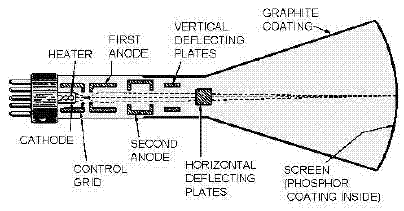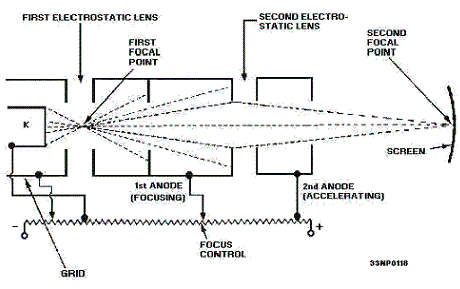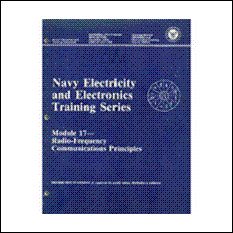The Oscilloscope
INTRODUCTION
The OSCILLOSCOPE is one of the most widely used pieces of electronic test equipment is . An o'scope is used to show the shape of a video pulse appearing at a selected equipment test point. Although some o'scopes are better than others in accurately showing video pulses, all function in fundamentally the same way. If you learn how one o'scope operates, you will be able to learn others.
As you will learn in this section on the oscilloscope, there are many different types of oscilloscopes—varying in complexity from the simple to the complex. Before we get into our discussion of the oscilloscope called a dual-trace , we will first present a general overview of the oscilloscope basic single-trace operation. Shortly, we will see how the oscilloscope uses a CATHODE-RAY TUBE (CRT) in which controlled electron beams are used to present a visible pattern of graphical data on a fluorescent screen.
Another
piece of test equipment used is the SPECTRUM ANALYZER. This test
equipment is used to sweep over a band of frequencies to determine what
frequencies are being produced by a specific circuit under test, and
then the amplitude of each frequency component. An accurate
interpretation of the display will allow you to determine the efficiency
of the equipment being tested.
CATHODE-RAY TUBES
A detailed discussion of CATHODE-RAY TUBES (CRTs) is presented in my tutorials on Electronic Emission, Tubes, and Power Supplies. Before continuing with your study of CRTs in this section, you may want to review these subjects.
Cathode-ray tubes used in oscilloscopes consist of an ELECTRON GUN, a DEFLECTION SYSTEM, and a FLUORESCENT SCREEN. All of these elements are enclosed in the evacuated space inside the glass CRT. The electron gun generates electrons and focuses them into a narrow beam. The deflection system moves the beam horizontally and vertically across the screen. The screen is coated with a phosphorous material that glows when struck by the electrons. The figure below shows the construction of a CRT.

Construction of a CRT.
ELECTRON GUN
The ELECTRON GUN
consists of a HEATER and a CATHODE to generate electrons, a CONTROL
GRID to control brightness by controlling electron flow, and two ANODES
(FIRST and SECOND). The main purpose of the first (FOCUSING) anode is to
focus the electrons into a narrow beam on the screen. The second
(ACCELERATING) anode accelerates the electrons as they pass. The control
grid is cylindrical and has a small opening in a baffle at one end. The
anodes consist of two cylinders that contain baffles (or plates) with
small holes in their centers.
Cathode and Control Grid
As in most conventional electron tubes, the cathode is indirectly heated and emits a cloud of electrons. The control grid is a hollow metal tube placed over the cathode. A small opening is located in the center of a baffle at the end opposite the cathode. The control grid is maintained at a negative potential with respect to the cathode to keep the electrons bunched together.
A high positive potential on the anodes
pulls electrons through the hole in the grid. Because the grid is near
the cathode, it can control the number of electrons that are emitted. As
in an ordinary electron tube, the negative voltage of the grid can be
varied either to control electron flow or stop it completely. The
brightness (intensity) of the image on the fluorescent screen is
determined by the number of electrons striking the screen. This is
controlled by the voltage on the control grid.
Electrostatic Lenses and Focusing
The electron beam is focused by two ELECTROSTATIC FIELDS that exist between the control grid and first anode and between the first and second anodes.
The figure below shows you how electrons move through the electron gun. The electrostatic field areas are often referred to as LENSES because the fields bend electron streams in the same manner that optical lenses bend light rays. The first electrostatic lens cause the electrons to cross at the first focal point within the field. The second lens bend the spreading streams and return them to a new, second focal point at the CRT.

Formation of an electron beam.
The figure above also shows the relative voltage relationships on the electron-gun elements. The cathode (K) is at a fixed positive voltage with respect to ground. The grid is at a variable negative voltage with respect to the cathode. A fixed positive voltage of several thousand volts is connected to the second (accelerating) anode.
The potential of the first (focusing)
anode is less positive than the potential of the second anode. The first
anode can be varied to place the focal point of the electron beam on
the screen of the tube. Control-grid potential is established at the
proper level to allow the correct number of electrons through the gun
for the desired image intensity.
Electron-Beam Deflection System and the factors influencing deflection
Vertical and Horizontal deflection plates
The-CRT Graticule, CRT designations, and the dual-trace oscilloscope control components
Front-Panel-Controls on a dual-trace oscilloscope
Dual -Trace components used to determine the amplitude of a signal
Components used to select the vertical operating mode
Components used to provide a stable display
Components used to select scope triggering and calibration of the probe
Using the Oscilloscope
Vertical-Deflection: Components Used to Select Vertical-Deflection Operating Mode
Other Dual-Trace Oscilloscope Controls and accessories















